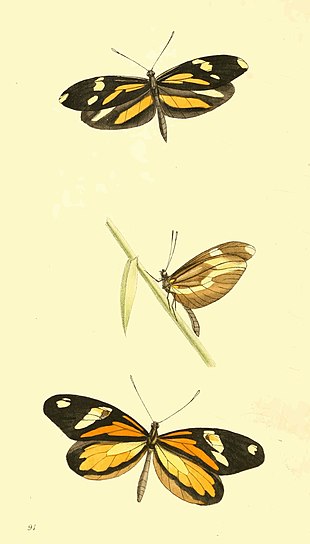Zoological Illustrations/VolII-Pl91

LICINIA Amphione.
Generic Character.—See Pl. 15.
Specific Character.
- L. alis integris, suprà nigris; anticarum basi maculo aurantiaco, triradiato, medio fasciâ flavâ, apice maculo flavo ornatis; posticis strigâ aurantiacâ, margine ferrugineo; antennarum clavis albis.
- Wings entire, above black; anterior with a three rayed orange spot at the base, and a central bend and terminal spot of yellow; posterior with an orange stripe and brownish margin; club of the antennæ white.
- Papilio Amphione. Cramer, pl. 232. f. EF.
- Pieris Amphione. Godart in Ency. Meth. vol. 9. p. 165. (Female.)
This is the only species among those I have united under the genus Licinia, which has any shade of red mixed in the colouring, all the others being variegated only with white, yellow, and black. It is a native of Brazil, and according to Godart of Guyana and the Antilles: though not common, it is sometimes frequent in local situations, preferring the borders of deep forests, and flying very slowly. I had the means of fully ascertaining the two sexes, of which the two upper figures are of the male, and the lower one the female. There can be no doubt the latter is the Pieris Amphione, so admirably described by M. Godart, who, however, makes no mention of the black marginal spots on the under side of the posterior wings, represented in Cramer's figure, which may therefore be a variety. More difficulty, however, exists in ascertaining if the male is distinct from P. Laia, of Godart: the figures of Cramer, in general, are so inaccurate, as always to excite a doubt in cases of nice discrimination; Godart's description, nevertheless, perfectly agrees with Cramer's figure: if it was, therefore, drawn up from the insect itself, there can be little doubt that Laia is distinct from Amphione; if, on the other hand, M. Godart made his description only from Cramer's figure, the question remains in its original uncertainty.
The club of the antennæ is white, tipt with pale brown. The under side of the female very closely resembles the upper, excepting that the black stripe on the lower wings is broken; and there are irregular blotches of white at the tips of both wings, but no marginal spots, as represented by Cramer.
It will be found that Licinia is the connecting genus between those of Danais and Pieris, of Latreille, and that the transition between the last of these and Colias is strongly marked by that of Terias, (Zool. Ill. pl. 22).
What with the inaccuracy of figures, and the almost universal neglect with which the most eminent entomologists have passed over this beautiful order, the natural arrangement and affinities of the Lepidoptera still remain in the greatest obscurity; and it is recommended to those who may object to the additional generic distinctions I have made, to examine, in the first instance, the relative validity they bear in essential character to the innumerable genera that are continually created in the Coleoptera, Hymenoptera, and Diptera.
